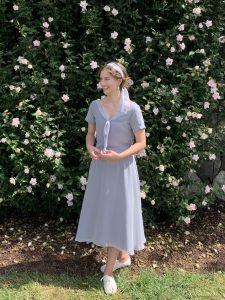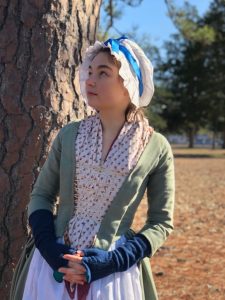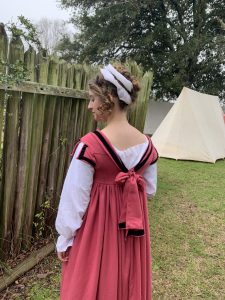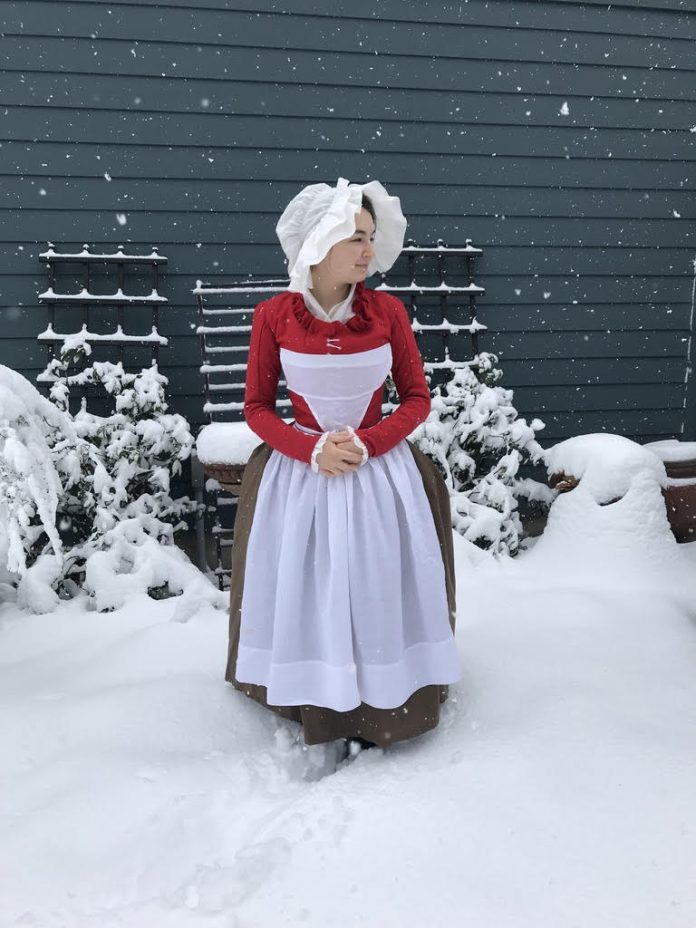Traversing between the 18th, 19th and 20th centuries, the historical garments donned by Gracie Patten ’23 (@graciesews) and Rachel Hogue ’24 (@_that_history_girl) are more than overzealous Halloween costumes. When they are not navigating the ups and downs of college life, Patten and Hogue are active members of a niche community of historical costuming enthusiasts. Driven by a combined passion for history and fashion, historical costuming served as the perfect outlet for creative expression for Patten and Hogue, who hunt down specific fabrics, construct entire outfits from scratch and showcase the final product on Instagram and YouTube.
Williamsburg attracts a sizable amount of tourists each year who seek out the “authentic” historical experience. From the Governor’s Palace to the Sir Christopher Wren Building, there is already plenty to go around for history buffs. Hogue’s interest in historical garb is inextricably linked with the campus.
“It really is Williamsburg that started it out for me because I was always really interested in history and people’s daily lives,” Hogue said. “Seeing people dressed up in historical garments as a job and as something that they could study was absolutely fascinating to me.”
The “Little House” books spurred Patten’s initial motivation.
“I’ve enjoyed sewing since I was about two,” Patten said. “And then around high school, I was like, well, I could actually make clothes…so I started making everyday skirts and stuff.”

Hogue feels that assembling an outfit that fits only the creator is more rewarding than ever.
“When I make 18th-century garments, I drape directly onto the foundational garments…” Hogue said. “You’re cutting the fabric onto the figure… because it’s made specifically for your measurements.”
For Hogue and Patten, it’s easy to determine an outfit to make and fabric stores offer a wide range of choices. Most of the heavy lifting takes place after the materials are gathered. Historical costumes typically consist of multiple layers to form different silhouettes — and the key to realistically imitating a historical outfit is the base layer.
“It probably took me two or three years before I was confident in the base layers that I had,” Patten said. “To make a dress, I could probably do that in twenty or thirty hours by hand. But all the stuff that comes before, all the research, it’ll end up taking years and years.”
Contrary to what a casual observer may think, historical costumes are not necessarily stand-alone pieces reserved for special occasions.
“As I’ve studied historical garments more, I think that it started to kind of blend a little where the historical garments have become part of my modern style,” Hogue said.
For Patten, 18th century clothing production comes easily material-wise now that she’s more familiar with the process of production.
“For me, the 18th-century clothing that I’ve made is more like a modern capsule wardrobe. I’m at a stage where I have everything that I need, and if I ever want a new garment, then I can immediately make that,” Patten said.

There are many reasons people choose to wear historical garments. While entertainment and pure interest play a large role in influencing choices, historical accuracy and academic enrichment are also factors.
“I think the 18th century is … my favorite historical period to research,” Patten said. “We both sometimes go to re-enactments, and it can be a really cool space to educate people about…the 18th century through clothing. You can take a cotton calf and say, ‘this is fashionable.’ Or you can use it as an educational tool to tell people about imperialism with the British East India Company … and other larger historical narratives.”
Hogue reflected on how costuming can help make connections between the past and the present.
“I was doing an interpretation event in Charleston, South Carolina last year,” Hogue said. “And I was talking about how sometimes 18th century women…would leave strands of pearls in their hair, like hair jewelry. One little kid started taking off his mom’s necklace and putting it into her hair, which was a really funny moment. Kids definitely connect with it.”
On the topic of educating through costuming, Patten and Hogue made sure to distinguish between conventional re-enactment events and ones that present a distorted, racist version of history.
“I actually grew up in South Carolina …so a lot of re-enactments … heavily focus on the Confederate lost cause,” Hogue said. “I will not touch that with a ten-foot pole. I don’t want to be involved in that, because they’re not looking at it from an educational standpoint, or if they are, it’s a very biased and quite frankly, racist view.”

The historical costuming community is not perfect, but many of its members have good intentions at heart.
“The people who make historical costumes on Instagram, 99 percent are super cool, really nice, down to earth. But there have been a few people who have said racist things or done things that people deemed culturally appropriative — and those people have always gotten completely smashed down,” Patten said.
Patten and Hogue recommended that amateurs look into costuming through a variety of mediums. Books are always a good place to start the journey, but Instagram, Facebook and YouTube all offer thriving accounts and forums for amateurs and enthusiasts to gather.
“I know that whenever somebody reaches out to me, I’m always happy to send along a couple of book recommendations, and I’m happy to guide them through any questions that they have,” Patten said.
For Hogue, costuming is a way to not only interpret history, but directly interact with it.
“Clothing — it’s very much a connecting factor,” Hogue said. “People today get up and get dressed; people in the past got up and got dressed. It’s a very tactile way … because you can talk about clothing, but when people can feel it … that changes how they understand that clothing.”

